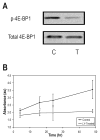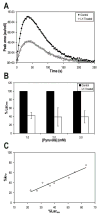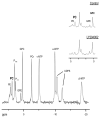Noninvasive detection of target modulation following phosphatidylinositol 3-kinase inhibition using hyperpolarized 13C magnetic resonance spectroscopy
- PMID: 20145128
- PMCID: PMC2822895
- DOI: 10.1158/0008-5472.CAN-09-2251
Noninvasive detection of target modulation following phosphatidylinositol 3-kinase inhibition using hyperpolarized 13C magnetic resonance spectroscopy
Abstract
Numerous mechanism-based anticancer drugs that target the phosphatidylinositol 3-kinase (PI3K) pathway are in clinical trials. However, it remains challenging to assess responses by traditional imaging methods. Here, we show for the first time the efficacy of hyperpolarized (13)C magnetic resonance spectroscopy (MRS) in detecting the effect of PI3K inhibition by monitoring hyperpolarized [1-(13)C]lactate levels produced from hyperpolarized [1-(13)C]pyruvate through lactate dehydrogenase (LDH) activity. In GS-2 glioblastoma cells, PI3K inhibition by LY294002 or everolimus caused hyperpolarized lactate to drop to 42 +/- 12% and to 76 +/- 5%, respectively. In MDA-MB-231 breast cancer cells, hyperpolarized lactate dropped to 71 +/- 15% after treatment with LY294002. These reductions were correlated with reductions in LDH activity to 48 +/- 4%, 63 +/- 4%, and 69 +/- 12%, respectively, and were associated with a drop in levels of LDHA mRNA and LDHA and hypoxia-inducible factor-1alpha proteins. Supporting these findings, tumor growth inhibition achieved by everolimus in murine GS-2 xenografts was associated with a drop in the hyperpolarized lactate-to-pyruvate ratio detected by in vivo MRS imaging, whereas an increase in this ratio occurred with tumor growth in control animals. Taken together, our findings illustrate the application of hyperpolarized (13)C MRS of pyruvate to monitor alterations in LDHA activity and expression caused by PI3K pathway inhibition, showing the potential of this method for noninvasive imaging of drug target modulation.
Figures






References
-
- Brader S, Eccles SA. Phosphoinositide 3-kinase signalling pathways in tumor progression, invasion and angiogenesis. Tumori. 2004;90:2–8. - PubMed
-
- Luo J, Manning BD, Cantley LC. Targeting the PI3K-Akt pathway in human cancer: rationale and promise. Cancer Cell. 2003;4:257–62. - PubMed
-
- Samuels Y, Wang Z, Bardelli A, et al. High frequency of mutations of the PIK3CA gene in human cancers. Science. 2004;304:554. - PubMed
-
- Hennessy BT, Smith DL, Ram PT, Lu Y, Mills GB. Exploiting the PI3K/AKT pathway for cancer drug discovery. Nat Rev Drug Discov. 2005;4:988–1004. - PubMed
Publication types
MeSH terms
Substances
Grants and funding
LinkOut - more resources
Full Text Sources
Other Literature Sources
Miscellaneous

